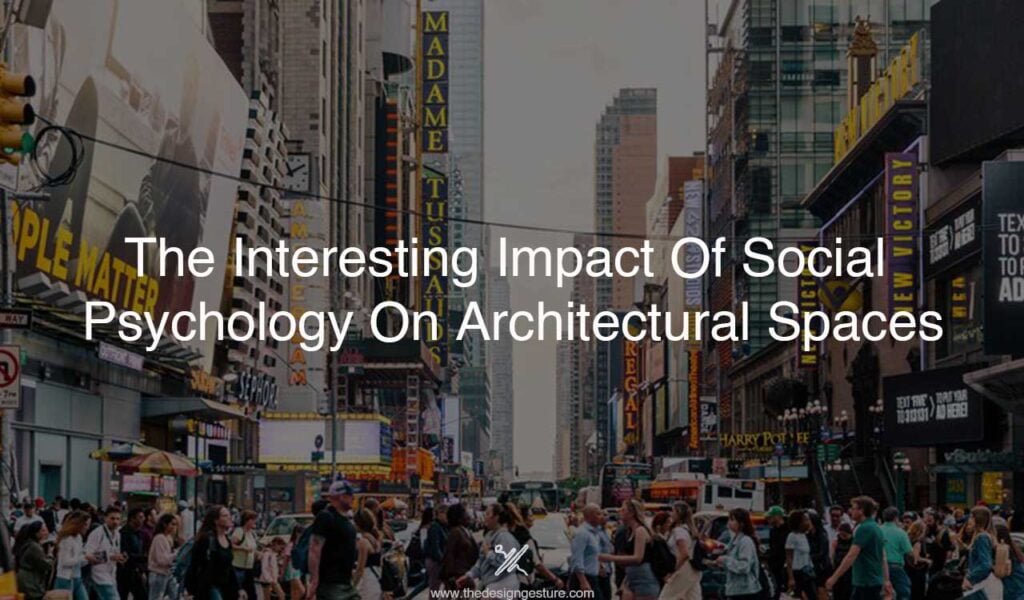Architectural structures, as products of long-lasting human activity, have a greater impact on the social psychology of humans and society. Human experience was once the fundamental guideline for designing buildings and cities. Since ancient times, architecture had been a process of people-oriented space creation, as it directly affected the lives of its inhabitants. The architecture of medieval cities focused on fulfilling human needs.
They built traditions and formulas for how to accommodate the human experience. However, since the modern era, cities and buildings became ‘machines’ with separate functions and parts. The emphasis on person-space connection was replaced with systems of bigger concerns, such as traffic. The understanding of the interplay between human activities and spaces was forgotten.
This impact of social psychology in the built environment can be understood through three levels: Spatial relationship (Relationship between spaces), Interpersonal relationship (Relationship between persons), and Person-space relationship (Relation between persons and spaces).
Table of Contents
Spatial relationship
Bryan Lawson, in Language of space, calls spaces the “settings” in which we behave and describes how our behavior is influenced by the settings. Bill Hillier says, “When we think of a particular kind of building, we are not only conscious of an image of an object but at the same time of the complex of spatial relations that such a building entails.” For example, a Christian church is not only the image of society but also organizes space for their rituals and uniquely locates each of the roles in the society of worship.
The choir, the clergy, and the congregation have their unique place, and the user visiting a new church will have no difficulty in knowing where to go and how to behave.
The design and spatial configuration of cities can make people more comfortable and engaged with their surroundings. One of the main objectives of the city that affects its users is navigation. For example, New York’s grid pattern makes it relatively straightforward and comfortable for its users, whereas London, with its different orientations and Thames meandering in the middle, is notoriously confusing. Kate Jeffery, a behavioral neuroscientist, found that to feel connected to a place, one needs to know the relationship between things spatially.
The sense of direction and spatial configuration is equally important inside buildings. Dalton has studied the Seattle Central Library and its spatial configuration. Though most of the architects admire the library, Dalton found it dysfunctional. The layout of each floor is different in the library and the escalators are located on different sides of the floor. It made the library disoriented and random. Hence, as Jeffery said, successful design is not much about how our buildings can shape us, but about making people feel they have some control over their environment.
Interpersonal relationship and social psychology
When two individuals talk, the space between them is the part of communication and it has the potential to encourage the interpersonal relationship between them. According to Durkheim’s theory, when individuals feel they belong to a group or they join a group, they benefit mentally, emotionally, and physically. This leads to the interpersonal relationship between individuals. Architectural spaces have an immense potential to affect the interpersonal relationships between their users. The form or grade of the relationship is directly related to the space or the social condition.
Interpersonal relationship based on space
The queue is one of the most obvious forms of conventionalized behavior that is triggered by the designed environment. When a person in a queue (in which we are standing) pushes the other in the front, we feel offended not only that we are at the back but also that they did not respect the rules. The token signals from the physical environment force people to behave in a highly artificial way in a queue. The rope barriers, although hardly restrict crowds, people would be more chaotic and aggressive without them.
The built spaces control and regulate human activities, behavior, and the way people come together and separate from each other. For example, walls, long distances, and high speed between people (preventive situations) restrain interpersonal relationships, whereas short distances, low speed, and right locations (supportive situations) encourage relationships. The spaces that are preventive are known as sociofugal spaces and those which are supportive are known as sociopetal spaces. Thus signals triggered by the environment have a huge impact on the interpersonal relationship between its users.
Interpersonal relationship based on social psychology:
Spaces play different roles under different social conditions. The spatial roles that affect human behavior are classified by Lawson in Language of space.
Confronting the role – When two people conflict, even in a game, they symbolically view the world from opposing angles, conceal any private information, and look into each other’s eyes.
Consorting role – When two people are collaborating, they tend to arrange themselves to ‘see the world from the same perspective’. In this case, the table only has one seat on each side, and they lean towards each other.
Conversational role – Two opposing sofas allow for looking into each other’s faces and thus reading all the non-verbal expressions. People sometimes choose to sit on the same sofa and turn to face each other rather than on different sofas.
Co-existing role – People generally adopt the ‘co-acting’ role if they are alone in a typical railway train layout. This allows them to ignore each other without rudeness, and here even the empty seats perform an important spatial role.
Person-Space relationship
Human behavior, experiences, and social expressions in spaces are the result of the processes of the conscious or subconscious mind that are influenced by the different features of these spaces. “When a person is tired of London, he is tired of life”, says Samuel Johnson. People are not immune to any built environment at any time. These preferences may also change from time to time.
And so, the person-space relationship is complex and dynamic. It may seem chaotic and irregular. Yet, physical, social, cultural, or sensory features share in common the power to affect people’s behavior and experience of the public realm. For example, humans always prefer certain spaces over others. They prefer a well-lit room with two windows over one. They prefer to walk in the street with less traffic. They prefer roads on the ground rather than the sky, etc. And, today, with the advancements in technologies in neuroscience and psychology, the person-space relationship and its impact on architecture can be best understood than ever.




